| In the Fall of 1965, Sergei Korolëv transferred responsibility for building lunar and planetary probes to the aircraft engineering firm, NPO Lavochkin, headed by his trusted colleague Georgii Babakin. The first generation of Lavochkin spacecrafts were Venus probes with descent modules. |
 Earlier 3MV Design (Venera-3)
Earlier 3MV Design (Venera-3)
|
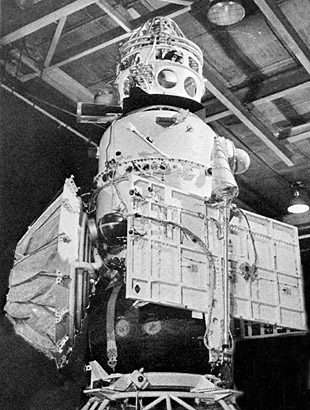 Improved Lavochkin Design (Venera-6)
Improved Lavochkin Design (Venera-6)
|
|
One of the first problems addressed by Babakin's team was the thermal control system.
A thermal vacuum chamber was completed in January of 1967, so systems could be tested under the quirky conditions of an insulating vacuum and strong radiant heat of the Sun.
Above, the radiator dome of Venera-3 is seen with tubes carrying liquid from hot or cold regions.
Lavochkin simplified the design, using the antenna as a thermal radiator and circulating the gas from the main compartment through pipes that spiraled behind the parabolic dish. This can be seen in the photo of Venera-6 above.
Note that the antenna faces opposite the solar cells, which allows it to radiate excess heat into outer space, as the journey to Venus takes it closer to the Sun.
Another new test facility was a 500g centrifuge, large enough to hold the descent module. Entering the atmosphere at a steep angle, less than 30° from vertical, these early Venus capsules experienced 350g to 450g overloads as they decelerated from 11 km/sec to sonic speeds. The first centrifuge test of a descent module resulted in almost complete destruction of its internal components, which suggests that earlier spacecrafts' landing capsules probably had no chance of survival. Note the image of Venera-6 is the actual spacecraft. The descent module is inside a thick dark-colored heat shield, unlike the shiny white modules usually displayed in museums. On both crafts above, solar panels and antenna are folded in their launch configuration. Venera-4 through Venera-8 were launched with the four-stage Molniia rocket, like earlier probes. Venera-4Using a different naming scheme than OKB-1, Lavochkin's first Venus probe was code named model V-67. It was outwardly similar to the 3MV model, but larger and heavier.
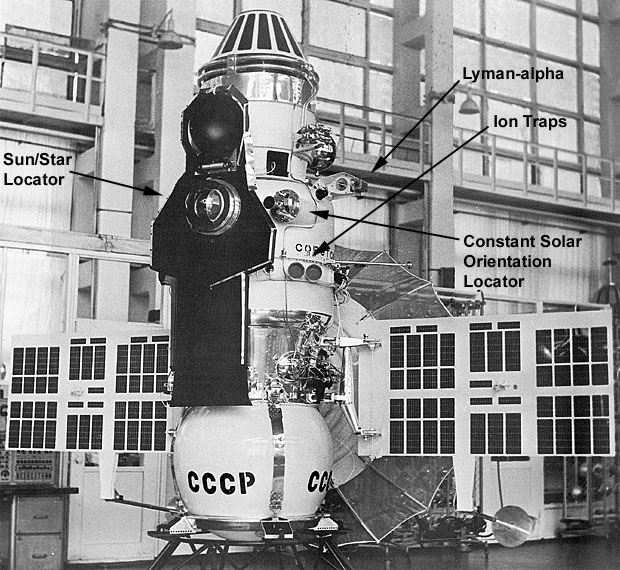
Venera-4 Spacecraft (Model V-67) The 1106 kilogram spacecraft carried a number of experiments on its main bus, including:
In the 34,773 km flyby of Mariner2, the magnetic field and ionosphere were two weak to be detected, but the strength of a dipole magnetic field decreases with the inverse cube of distance. The Venera-4 bus would impact the planet, and its ion traps and magnetometer would come close enough to get the first measurable readings. Minute traces of hydrogen and oxygen around the planet could be detected by sensing their fundamental Lyman-α wavelengths in the extreme ultraviolet. As a consequences of the 22-year Solar magnetic cycle, Soviet cosmic-ray measurements declined by 25% from Venera-2 to Venera-4, and another 15% when measured by Venera-5. |
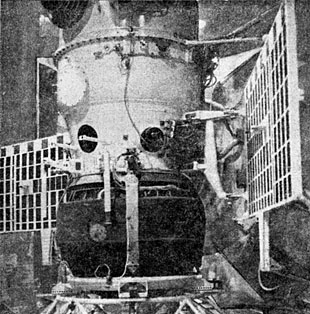 Venera-4 Descent Module In Place
Venera-4 Descent Module In Place
|
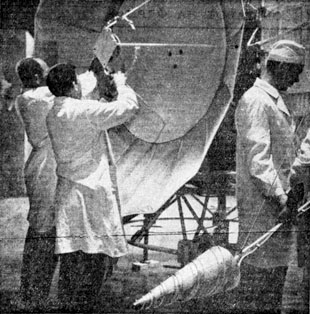 Venera-4 Antennas
Venera-4 Antennas
|
|
Another view of an actual launched Venera probe, above left, shows the descent module with its thick heatshield. Heavy straps hold the lander in place, and pyrotechnic charges release it before planetary encounter, on command from Earth.
On the right, the large parabolic antenna is seen, as well as one of the conical spiral semidirectional antennas in the foreground. During telemetry sessions and during final approach to Venus, the spacecraft would keep the high-gain antenna aimed at the Earth. The conical antennas were telecommand receivers, mounted perpendicular behind the solar panels. During flight, the spacecraft slowly turned on the Solar axis, and the antenna's funnel-shaped radiation pattern was angled to concentrate its reception from the Earth.
 Venera-4 descent module The descent module was 1 meter in diameter and weighted 383 kilograms, seen above with lid and parachutes removed. A (red) flag-shaped pennant can be seen on the left inside rim of the capsule. The helical antenna in the center broadcast on 922 MHz with a circularly-polarized pear-shaped radiation pattern designed to concentrate the signal toward the zenith. The landers were aimed at the night side of the planet, in the center of the disk as seen from Earth. Since the antenna was not high gain or high powered, the telemetry rate was 1 bit per second, respectable at that time. Two transmitters were included for safety. Onboard experiments included:
|
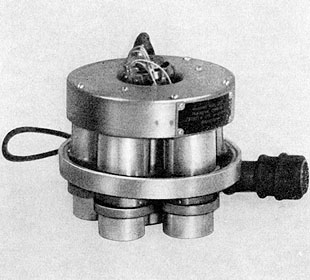 G-8 Gas Analyzer
G-8 Gas Analyzer
|
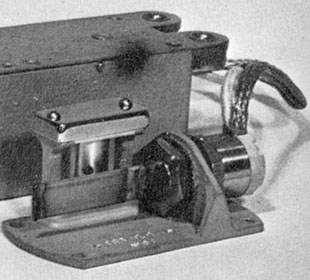 Temperature & Density Sensor
Temperature & Density Sensor
|
|
The thermometers had ranges of 210-730° K (36.8 Ω) and 270-600° K (16 Ω).
This design provided a more accurate reading over the expected range, and a less accurate reading over a wider range just in case.
The densitometer had a range of 0.0005-0.015 g/cc and was integrated with the thermometers in the
IS-164D unit.
The barometer was designed to measure 0.13-6.9 ± 0.2 atmospheres.
Venera-4 measured the four gases believed to be present in significant amounts: carbon dioxide, nitrogen, oxygen, and water vapor.
Two chemical gas analyzer units contained a total of 11 experiments.
Manometers measured pressure differences between pairs of chambers, in which different chemicals absorbed and removed specific gases.
More sensitive measurements were made experiments involving electrical resistance of moisture-absorbing surfaces or oxidation of heated filaments.
In 1967, most astrophysicists in America and Russia believed that Venus was extremely hot, but one MIT paper that year suggested the planet could be experiencing an Ice Age! Surface pressure on Venus was even more of a scientific guessing game at that time, with published estimates ranging from 3 to 1000 atmospheres. This uncertainty resulted from the inaccuracy of spectrographic methods, which measured conditions at the cloud tops, and from uncertainty about the depth of the atmosphere and the radius of the planet's hard surface. Estimates of 10 to 30 atmospheres of pressure at the surface were commonly believed. The presence of carbon dioxide was obvious from infrared spectroscopy; and prior to Venera-4, a composition of 15% CO2 and 85% nitrogen was considered likely. |
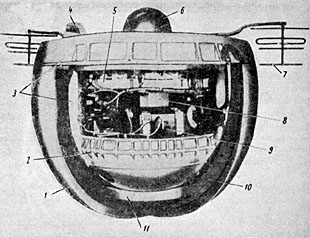 Cutaway View Showing Heat Shield
Cutaway View Showing Heat Shield
|
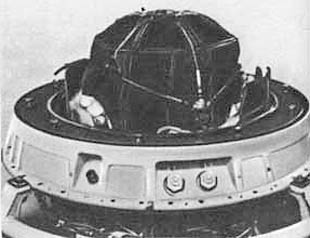 The parachute pack
The parachute pack
|
|
Early experiments with warhead reentry had taught Soviet and American engineers that sharp-nosed vehicles are destroyed by friction.
However, a blunt body creates a shockwave, heating atmospheric gas to a plasma and carrying away most of the heat.
Significant energy is still transferred to the vehicle by radiant heat from the incandescent shockwave, and ablative heat shields were developed to absorb this heat and sublimate or burn away in layers.
The heat shield of the Venera capsule was a lightweight porous material, probably based on phenolic epoxy resin.
Inside the capsule, a moving damper prevented destructive vibrations from building up.
Equipment was designed to withstand the estimated 300 g maximum deceleration during reentry.
Hanging out over either side of the capsule were antennas of the radio altimeter. They were packed with the main parachute and designed to spring into position when it deployed.

FMCW Radar Altimetry Venera-4 used a frequency-modulation continuous-wave altimeter (FMCW), built at the Research Institute for Space Device Engineering (RNII KP). Commonly used in aviation, the method is illustrated above. A radio wave is transmitted with a ramping frequency, and the signal bounces back from a surface to a receiver. The distance to the surface is indicated by the frequency difference between the transmitted and received signals. To conserve limited telemetry bandwidth, a single message was sent when a narrow-band filter detected a frequency difference corresponding to an altitude of h = 26 ± 1.3 km. As the diagram above shows, distances of ... h-A, h, h+A, h+2A ... yield the same frequency difference. This is called integer ambiguity. Venera-4's altimeter operated on 770 MHz and had an ambiguity distance of about A = 30 kilometers. By comparison, the more recent Magellan mission used an altimeter with an integer ambiguity of 10 kilometers. There is a design tradeoff: shortening the ambiguity distance increases accuracy but makes resolution of ambiguity more difficult.
 Venera-4 Temperature Telemetry Venera-4 was successfully launched on June 12 1967. Every few days, the spacecraft would point its antenna to Earth, and transmitted recorded space-science data. The first discovery made by Venera-4, shortly before encounter, was the existence of a hydrogen corona, driven off the atmosphere by the Solar wind. On October 18, the descent module separated from the spacecraft bus, and both impacted the planet. The target point was the night side of Venus, near the morning terminator. From this position, the Earth would be directly above the capsule as it transmitted its findings from a semidirectional antenna. At a barometric pressure of 0.6 atm, explosive bolts ejected the lid and released a 2.2 square-meter brake parachute. A short time later, the 55 square-meter main parachute and the radio altimeter antennas deployed. Sensor data was transmitted in round-robin order by the commutator unit, as the capsule drifted slowly into the deep atmosphere. The barometer, densitometer and two thermometers were interrogated 23 times during the 93-minute descent. The temperature readings, shown above, ranged from 31° C to 271°C. The initial pressure reading was 0.75 atmospheres, which increased to the limit of the sensor well before the end of the mission. The final pressure was an estimated 18.5 atmospheres. M.Ia Marov and V.S. Avduevskii applied sophisticated thermodynamic analysis of these results, and created a model of pressure and thermal transfer. Their model of the Venusian atmosphere would be refined by data from all subsequent Venera missions.
Five gas-analysis experiments (the G-10 unit) were triggered shortly after the main chute opened, and six more (the G-8 unit) were triggered 6 minutes later. Scientists knew that carbon dioxide was present, but they were surprised by the very large amount, 95%. It was previously believed that nitrogen would be the major component of the Venusian atmosphere, which is why a second manometer, activated at higher pressure, would have measured the range of 2 to 30%. Carl Sagan wrote that Venus must have 15-50% nitrogen, speculating that Venera-4 had malfunctioned. However, the Soviet result has been confirmed by many subsequent measurements. Soviet geologist A.P. Vinogradov explained the result as the outgasing of carbonates in the crust of Venus. The most controversial result from Venera-4 was the altimeter reading. The "26-kilometer" message was sent shortly after the start of telemetry. At first, it was assumed that Venera-4 stopped transmitting when it hit ground. A surface pressure of 18.5 atm was about what many scientists expected, and the temperature of 544° K (271° C) was only slightly cooler than the 600° K predicted by the planet's microwave brightness. Furthermore, the descent capsule was designed to withstand 25 atm or pressure, well above the final reading of 18. Aerodynamic calculations and Doppler radio measurements estimated 28 kilometers of descent. This was coincident with the 26 km altimeter reading, adding weight to the conclusion that the capsule impacted the surface. However, Venera-4 did not reach the surface of Venus intact. From modern atmospheric models, we know telemetry began at 55 km, which is very close to the 26 + A. The radar altimeter had functioned correctly, but the integer ambiguity had not been correctly resolved. Atmospheric pressure may have breached the capsule at an altitude of about 22 km, but more likely it ran out of battery power in the long slow descent. Designed with 100 minutes of battery life, Venera-4 stopped transmitting at 93 minutes. Eventually, the lid of the instrument compartment would have cracked and admitted the atmosphere, its parachute would have incinerated, and in the thick atmosphere it would have landed with a hard bounce (popular descriptions of violent implosions are probably melodramatic). It landed somewhere near latitude 19° N, longitude 38° E.
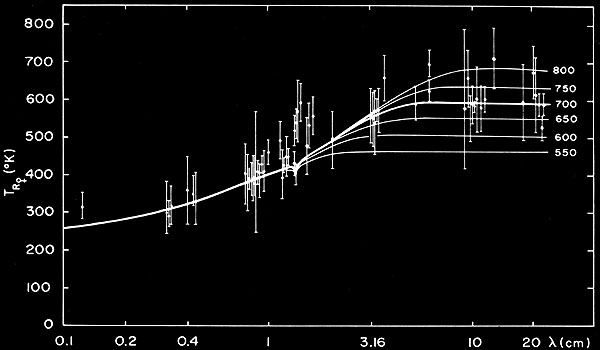
Revised Radio Temperatures Conditions on the surface of Venus were finally interpreted consistantly by Soviet radio astronomer A.D. Kuz'min. Using the chemical analysis of the Venusian atmosphere, with its unexpected high-pressure carbon dioxide atmosphere, he recalculated the microwave thermal spectrum of Venus. The unusual form of the microwave spectrum was at last explained by atmospheric absorption and high surface temperature. But the new estimates of surface temperature, 427 ± 100° C (700° K), were inconsistent with the final Venera-4 measurement of 271° C. America's Mariner-5One day after Venera-4, a second probe arrived at Venus and performed a simple but important experiment. Mariner-5's results, combined with Venera-4 and Earth-based radar data, would finally reveal the hellish conditions of the surface of Venus.
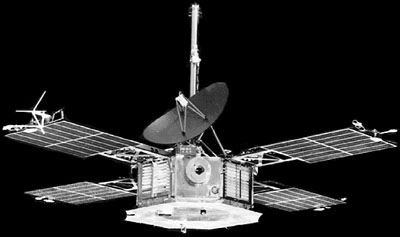 Mariner-5 (1967) America launched the 245 kilogram Mariner-5 on June 14, and it arrived at Venus on October 19. This was a backup copy of the Mariner-4 Mars probe, with no camera. Its primary mission was an S-band radio occultation. As it passed behind Venus, its signal began to intersect the atmosphere, slowing down slightly as it passed through more and more matter. The traversal time was measured from the phase changes in a 320 KHz tone generated by a temperature-stabilized crystal oscillator onboard the spacecraft. |
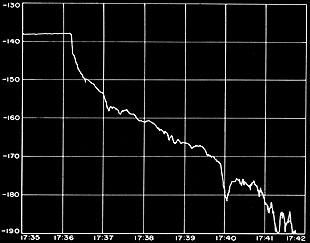 Occultation of Mariner-5 Radio Signal
Occultation of Mariner-5 Radio Signal
|
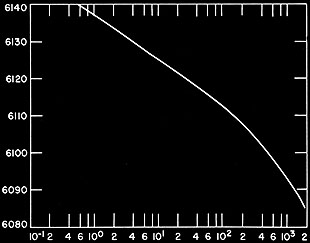 Calculated Refractivity, (n-1)×106
Calculated Refractivity, (n-1)×106
|
|
As seen above, the signal strength faded gradually during the six-minute occultation. The absence of an abrupt cutoff meant the hard surface of Venus was not detected.
Mariner-5's signal penetrated to a distance of 6085 kilometers from the planet's center, but how much deeper did the Venusian atmosphere extend?
A profile of the gas refractivity was computed by gradual adjustment until the measured signal phase delay was accounted for correctly. Density could be estimated from refractivity, if the chemical makeup of the atmosphere is known, and this information was provided by Venera-4. Now the atmospheric profile from Mariner-5 could be lined up with the measurements from Venera-4, and the two data sets matched. The Kitt Peak ConferenceIn March of 1968, Soviet and American scientists gathered in Tuscon Arizona to compare and discuss results. They met again at the COSPAR meeting in Tokyo in May, The Physics of the Moon and Planets Symposium in Kiev in October, and the next year at the Symposium on Planetary Atmospheres and Surfaces at Woods Hole in August 1969. The major American and Soviet scientists were regularly meeting face to face, fostering the beginnings of communication, cooperation and mutual respect.
It was ultimately agreed that neither Mariner-5 nor Venera-4 had detected the surface of Venus. However, Earth-based radar had probed the surface of the planet and provided estimates of its radius. Putting all the facts together, surface conditions of 427° C and 75 atm were extrapolated. For the first time, the true nature of Venus was known, fairly accurately and with confidence. These conclusions were not reached without some dispute. At the powerful Ministry of General Machine Building, a committee had weighted early evidence and decided to announce that Venera-4 had landed. This was not as unreasonable as some Western historians suggest. Transmissions had ended well before the designed crush depth of the probe, the altimeter reading closely matched the calculated distance of descent, and temperatures were (just barely) within the limits of early hot-surface theories. But Kuz'min's new temperature calculations, the results of radar, and the measurements of Mariner-5 would soon contradict this conclusion. The issue came to a dramatic head at the COSPAR meeting, when the world's two leading experts, Carl Sagan and Arkadii Kuz'min, debated the landing. Kuz'min's own experiments had proved that Venus was too hot to match Venera-4's final thermometer readings, but he suggested that it could have landed on an extremely high plateau or mountain. Sagan argued that the probe's batteries had run out before it reached the surface, and radar studies were not consistant with such mountainous terrain. Subsequently, Soviet news agencies announced that they had been mistaken, and Venera-4 had not reached the surface. Ultimately, whether or not Venera-4 landed was mainly an issue of propoganda. The probe had achieved all its mission objectives. Previous Venus landers (2MV, Zond-1, Venera-3) contained surface radiation and motion experiments, designed at the Institute of Nuclear Physics. After them, Keldysh created the Space Research Institute and reorganized responsibility for experiments. Venera-4 to Venera-7 contained no instrumentation specifically for surface study. Venera-5 and Venera-6The 1138 kilogram V-69 spacecrafts contained a virtually identical bus with the same radiation, plasma and Lyman-α detectors as Venera-4. The 405 kilogram descent module was strengthened to withstand 450-g reentry forces, because the 1969 launch window required a higher velocity approach to Venus. Experiments in the descent capsule were updated to refine and extend the results from Venera-4:The chemical analysis experiments were improved. Given the atmospheric composition measured by Venera-4, more accurate analysis could be done within a narrower dynamic range. Six barometers were added to cover three dynamic ranges, each with duplicated sensors: 0.13-6.6 atm, 0.66-26 atm, and 1 to 39 atm. This would allow both temperature and pressure readings during the full expected lifetime of the mission. A new type of densitometer was designed to function over a wider range, 0.5 to 40 kg/m**3, measuring the amplitude of a 160 Hz tuning fork.
 The layout of the Venera-5 descent vehicle:
The Venera-5 spacecraft was launched on January 5, 1969, and its sister mission Venera-6 was launched on January 10. They arrived at Venus on May 16 and 17 respectively. Venera-5 took chemical readings at 0.6 and 5.0 atmospheres, and Venera-6 at 2.0 and 10.0 atm.
Venera-4 was prepared for a wide range of possible atmospheric compositions, and in particular, nitrogen had been expected in great abundance. On Venera-5 and 6, the gas analyzers were reconfigured to refine the accuracy within narrowed dynamic ranges. Nitrogen (and other inert gases) was measured by removing all reactive gases (carbon dioxide, oxygen, water). Extra experiments were performed to pin down the amounts of water and oxygen. More accurate manometer readings were obtained by transmitting a pressure reading at the moment of analyis, and Venera-6 was set to start analysis at a higher pressure. The final result deduced from all the measurements of Venera-4 to 6 was: carbon dioxide 97±4 percent, nitrogen less than 2 percent, oxygen less than 0.1 percent, water vapor 6 to 11 mg per liter. Again, data was telemetered at 1 bit/sec. A system of relays and commutators controlled the multiplexing of information, triggering one-time messages like a chemical analysis experiment, and periodically sampling the continuous sensors and internal housekeeping. At intervals of 45 seconds, over 70 temperature and 50 pressure readings were transmitted.
The radar altimeters were improved by adding three frequency-difference filters that trigger altitude messages. These were designed to correspond to altitudes of about 35, 25 and 15 kilometers (modulo an ambiguity of about 30 km). The published temperature and pressure readings the corresponded to altimeter messages can be compared with the modern Venus atmosphere model, to see what the altitudes actually were. The results appear fairly normal and consistent, given the accuracy of about ±1.3 km. At the time, there was controversy about altimeter readings, and it was thought that Venera-5's altimeter readings corresponded to 45, 35 and 25 km. The 10 or 11 km discrepancy could not be explained, but was probably due to the less accurate atmospheric model of that time, and possibly to confusion about which altimeter filter was reporting. Like Venera-4, in the final analysis, the radar altimeters behaved normally. Both probes survived for a little over 50 minutes, reaching levels where the temperature was about 320° C and pressure about 27 atm. Telemetry showed the inside temperature climb from 13° to 28° C -- the probes were cracked open by pressure well before being cooked. Venera-5 eventually came to rest at 3° S, 18° E, and Venera-6 landed at 5° S, 23° E. Venera-5 and 6 landed on the night side of Venus, in the center of the visible disc of the planet. However, they did contain photometric sensors. Astronomers have observed that the night side of Venus occasionally glows, a phenomenon called Ashen Light, which is still a controversial mystery. The photometers registered darkness except for one reading from Venera-5, four minutes before it went silent, reporting 50 times the light level of all other readings. Possibly the first evidence of lightening, or a transient effect of the capsule's breech. |
Venera-7Following Venera-4 to 6, Soviet engineers were determined to reach the surface intact, with the V-70 model descent capsule. It was more egg-shaped than previous models, and weighted over 490 kilograms. Inside was a spherical titanium hull, designed to withstand higher pressure than the previous hemispherical capsules with flat lids. Babakin and his deputy, V.G. Perminov, no longer trusted the surface pressure estimates being received from the scientists. Privately, they set the design to 180 atm crush pressure.For testing, a pressure chamber was constructed, capable of 150 atm and a temperature of 540° C. It could be filled with a mixture of carbon dioxide and nitrogen to simulate the effects of the Venusian atmosphere. Besides the effects of pressure and temperature, it is also the case that supercritical carbon dioxide is a powerful solvent. Venera-7's descent capsule was massively overbuilt and had little room for extra scientific gear. It is believed to have contained only thermometers, barometers and a pulse modulation radar altimeter. |
 Venera-7 spacecraft
Venera-7 spacecraft
|
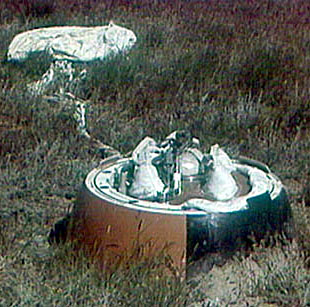 Descent capsule testing
Descent capsule testing
|
|
It was necessary to get down through the hot atmosphere quickly, but not hit the surface too hard. To accomplish this, the main parachute was reefed, a cord wrapped around the parachute cables held the mouth of the chute closed like a goblet, and the capsule descended rapidly. At a temperature of 200° C, the reefing cord was designed to melt, allowing the chute to open fully for a soft landing.
Of course the parachute itself had to withstand over 500° C, and it was made of a heat resistant fiber of unknown composition ("glass nitron").
To further prolong mission time, the capsule was precooled to -8° C before separation from the main spacecraft.
The 1180 kilogram Venera-7 was launched on August 17 1970. A sister ship was stranded in orbit five days later. Venera-7 reached Venus on December 15 and became the first spacecraft to successfully land on that planet. Frequency shifts in its carrier were monitored to very accurately compute its velocity, by Doppler effect. A fault in the commutation unit caused only temperature readings to be transmitted, but it was valuable data that improved the extrapolation of atmospheric properties down to the surface.

Spectrogram of Venera-7's Doppler-Shifted Radio Signal The 35-minute descent of Venera-7 was a wild ride, as later analysis of Doppler speed and aerodynamics indicate. At 13 minutes, the speed of descent slowed abruptly, as the reefing cords released. However at 19 minutes, the rate of descent suddenly increased and continued to increase for several minutes. An oscillation in the velocity was observed, and it is believed that during this time the parachute was tearing, and the capsule was swooping and gliding. A few minutes before landing, speed increased to free-fall and swooping ceased, due to extremely turbulent atmospheric conditions collapsing the parachute. Venera-7 struck the surface at 17 meters/sec (38 miles per hour). At first, it was believed destroyed on impact, but later analysis of the recorded radio signal found faint telemetry above the background noise. At the moment of impact, the signal dropped to 3 percent power, came back to full strength for a second, then remained at 3 percent for 23 minutes before ending. This suggests the capsule bounced on impact and came to rest at an estimated 50° angle. Data was being transmitted at 1 bit/sec on 922 MHz using frequency-shift keying (FSK), that is binary data was being sent by switching between two frequencies that differed by about 45 Hz. The reported surface temperature changed between adjacent binary codes for 457° C and 474° C. Venera-7 came to rest at 5° S, 351° E. The radio Doppler velocity measurements and aerodynamic calculations on Venera-4 to Venera-7 revealed a surprising fact. The atmosphere of Venus has a fast retrograde wind at high altitudes, much faster than the rotation of the solid planet. Super rotation is still somewhat mysterious, but recent computer simulations by Del Genio suggest that absorption of solar heat by the cloud layer creates high-altitude circulation, uncoupled to ground friction. Doppler measurements showed that wind velocity at the surface was less than 2.5 m/sec. The fact that the capsule survived impact at 17 m/sec was used to estimate the bearing strength of the soil. The upper bound of 80 kg/cm**2 corresponds to volcanic tuff. This is consistent with penetrometer and accelerometer results from later landers. Venera-8The clouds and the surface geology of Venus were major open questions by 1972. Venera-4 to Venera-6 answered important questions about the temperature, pressure and chemical makeup of the Venusian atmosphere. However, the extent and makeup of the clouds were still unknown, and the Soviet atmospheric probes did not find enough moisture for the condensation of Earth-like clouds of water droplets. Sophisticated spectroscopy was indicating the upper layer was probably a fine haze of concentrated sulphuric acid.
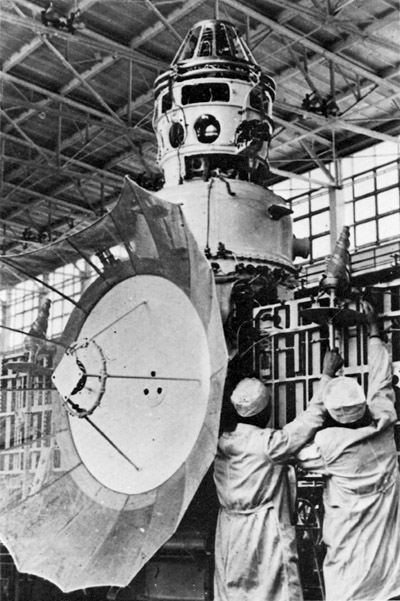 Venera-8 spacecraft V-72 would be the final model of Lavochkin's first-generation Venus probes, launched by the Molniia rocket. Lavochkin was intensely busy during this time, with a series of heavy and sophisticated Moon probes (sample return missions, and the Lunokhod rovers). Lavochkin engineers had designed a second generation of multipurpose planetary probes, five times the size of V-72 and launched by the Proton rocket. These had already been sent to Mars in 1971. Sadly, chief designer G. N. Babakin had also died that year. |
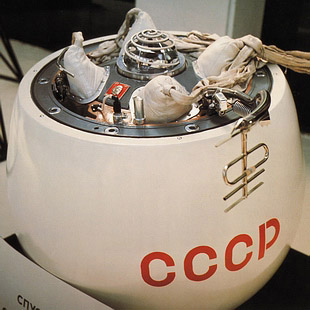 Venera-7 descent module
Venera-7 descent module
|
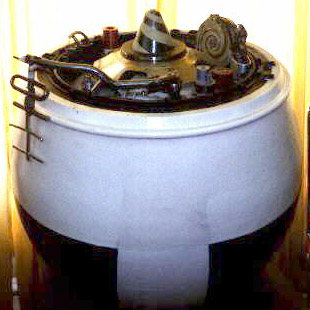 Venera-8 descent module
Venera-8 descent module
|
|
The Venera-7 mission had been designed to land on the night side of Venus, facing the Earth.
Its hemispherical spiral antenna had an egg-shaped radiation pattern to focus the 922 MHz signal toward the zenith.
To allow the V-72 missions to measure sunlight, they were designed to land within the illuminated crescent seen from Earth, still in radio line-of-sight. However, the Earth would be low on the horizon, so the conical spiral antenna had a funnel-shaped radiation pattern.
To avoid the problem of being tipped on its side, a secondary antenna connected by cable would be ejected. It was a flat disk shape, with spiral antennas on both faces. After ejection, a gravity switch would connect the upward-facing antenna to the transmitter.
The flat spiral ejectable antenna can be seen next to the rim, to the right of the main antenna. Following the rim clockwise, small red and blue cylinders are seen emerging from the pressure hull, a photometer and the ammonia analyzer. Next is the single radar altimeter antenna (Venera-7 appears to have a similar altimeter, but results were never reported, possibly because of its commutator failure). 180° from the first photometer is the red cylinder of a second one, duplicated in case of a malfunction.
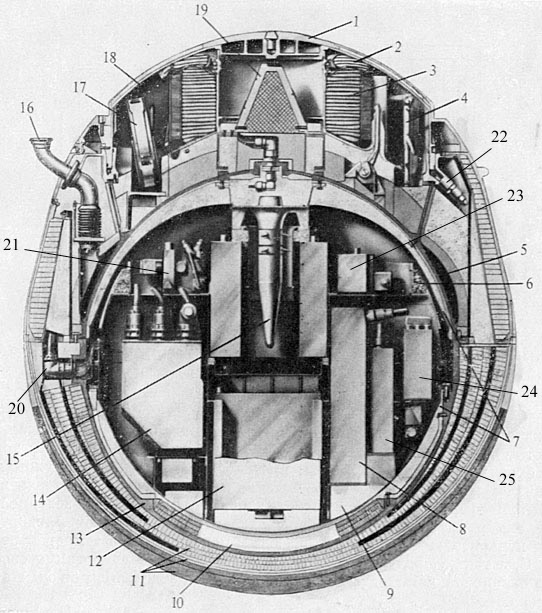 Layout of Venera-8 descent module
The surface temperature and pressure on Venus were now known, so the Venera-8 capsule (495 kg) could have less pressure hull and insulation and more scientific equipment. |
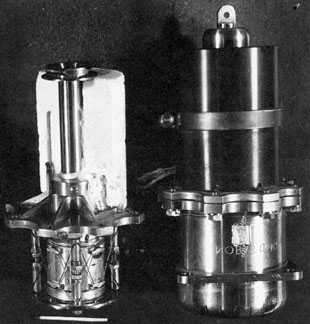 Venera-8 Photometer
Venera-8 Photometer
|
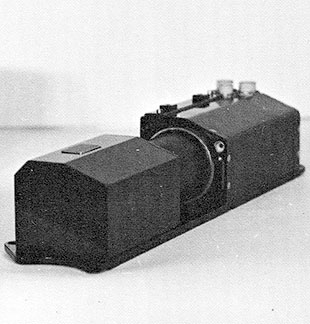 Venera-8 Gamma-Ray Spectrometer
Venera-8 Gamma-Ray Spectrometer
|
|
Duplicate cadmium sulphide photometers
would measure the attenuation of sunlight as the capsule drifted down through the clouds.
These could report a range from 1 to 10,000 lux, encoded logarithmically.
With future photography missions in mind, they would test if light penetrated all the way to the bottom of the Venusian "ocean" of carbon dioxide.
A second experiment was a gamma-ray spectrometer. A scintillator detector measures the energy of individual gamma rays by the flashes of light they produce in a crystal. Three of the common elements are radioactive: potassium, thorium and uranium, each of which emits a characteristic gamma-ray energy, 1.46 MeV, 2.62 MeV, and 1.76 MeV. The ratios of these light and heavy metals varies between different minerals. This instrument is able to sit within the pressure vessel, and was calibrated against a variety of igneous rocks on the Earth. A similar instrument was carried by Luna-10, the first spacecraft to orbit the Moon.
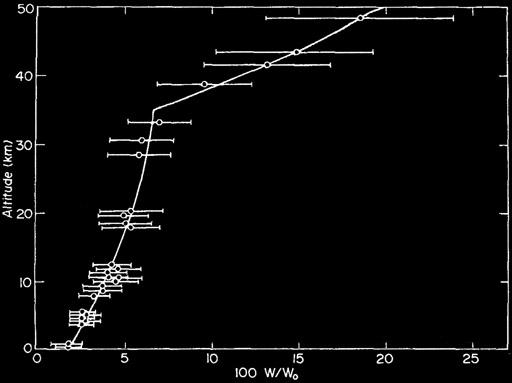 The 1184 kilogram Venera-8 probe was launched on March 27, 1972, but its sister ship was stranded in orbit four days later. It arrived and the 495 kilogram descent module entered the atmosphere on July 22. After 55 minutes, Venera-8 came to rest within a 150 km radius of 10.70° S, 335.25° E, and it continued to transmit scientific data for an additional 50 minutes. The photometer readings are shown above, indicating the percentage of sunlight penetrating to various altitudes. 27 light levels were returned along with 9 measurements of the photosensor's temperature. Illumination decreased rapidly down to about 35 kilometers; but below that altitude, the extinction of light was no more than clear carbon dioxide would have produced. This was the first evidence that the cloud layer of Venus had a floor. Landing near the morning terminator, the Sun was only 5° above the horizon, although its illumination would have been uniformly diffused below the cloud tops. The gamma-ray spectrometer reported rock containing 4 percent potassium, 2.2 parts per million uranium and 6.5 ppm thorium. This is more like granite than basalt (unlike measurements from all later Venera landers). High resolution radar imaging, made many years later, corroborated this finding, since Venera-8 landed in a region of steep sided volcanoes, thought to be older than the lava plains of basalt that cover most of the planet. 35 altimeter measurements were returned, ranging from 45.5 to 0.9 kilometers. They agreed well with the altitudes calculated from Doppler radio and aerodynamic simulation. Two echo intensity readings were returned, from which the ground density (about 1.4 g/cc) and dielectric constant were calculated. Along the capsule's 60 km horizontal drift, surface ruggedness of 1.2 km variation was seen in altimeter readings. An ammonia analyzer operated at barometric levels of 2 and 8 atmospheres, based on bromophenol blue, a "litmus test" for NH3. At that time, ammonium pyrosulphite was considered a possible component of the clouds, and the sulphuric acid theory was just beginning to be discussed. An abundance of 0.01 to 0.1 percent was detected, but this is generally believed to be an overestimate. |
 G.N. Babakin
G.N. Babakin
|
 K.P. Florenskii
K.P. Florenskii
|
 V.V. Mikhnevich
V.V. Mikhnevich
|
|
Acknowledgements: Many image are from NASA and come courtesy of their generous non-commercial usage policy. In particular, many are from the web site of David R. Williams, National Space Science Data Center, nssdc.gsfc.nasa.gov. The color movie frames of Venera-7 is courtesy of Vladimir V. Semenov of VideoCosmos. Special thanks to Aleksander Bazilevskii, Vladimir Kurt and Arkadii Kuz'min for the comments and recollections about Venera-4 through Venera-8. |